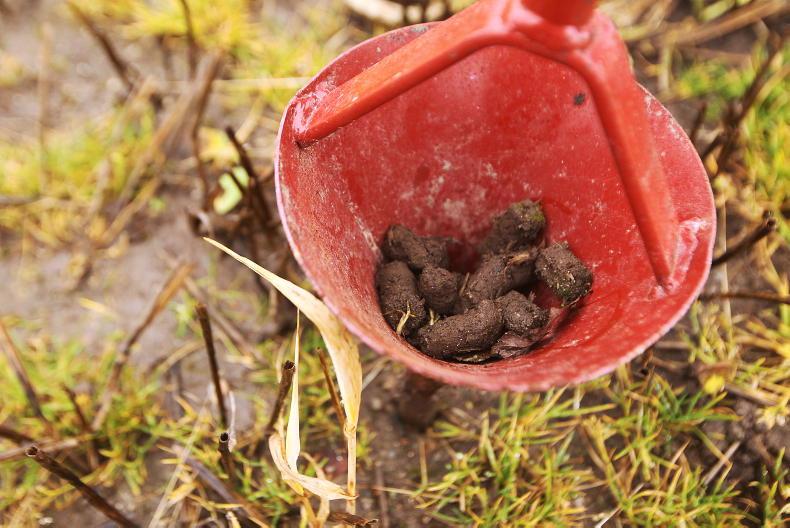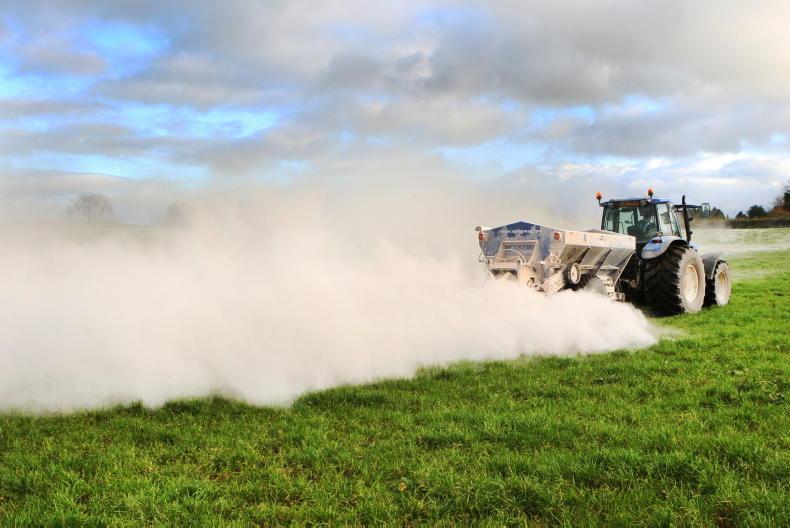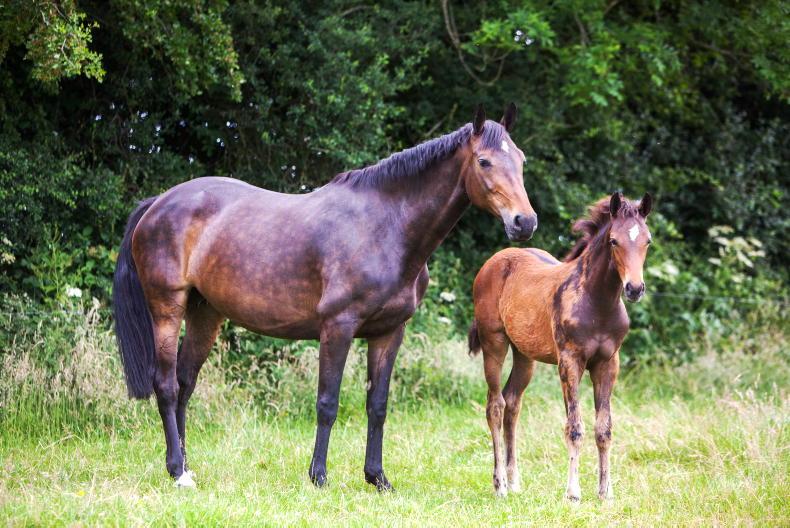ONE way of explaining sustainability is that it focuses on meeting the needs of the present while also ensuring the ability of future generations to meet their needs. As a concept, sustainability encompasses three key elements: economy, environment and society. Environmental sustainability at farm level is increasingly important. Here are some suggestions to consider ways of contributing to improving sustainability on your farm.

Soil testing will help assess soil fertility and help you develop a Nutrient Management Plan (NMP) for your fields / Irish Farmers Journal
SOIL HEALTH
A phenomenal number of organisms live within soil including bacteria, fungi, archaea, protozoa, insects and earthworms which are integral to the health and productivity of the soil. They are intrinsic to plant establishment; recycling, transforming and scavenging nutrients for plant growth; providing essential plant vitamins and hormones; suppressing pests, pathogens and disease; protecting against plant stress; regulating climate; and maintaining soil structure.
Grab a spade and dig out a small block of soil
Much can be learned about the health of soil biology from visual assessment including examining colour, structure, plant rooting patterns and observing or counting larger organisms such as earthworms.
Evidence of soil damage can also be evaluated such as water ponding at surface, colour mottling indicating water stagnation and compaction indicating poor soil porosity leading to many negative effects in the soil. These are quick and easy to do. Pick a few areas of the farm to compare different managements including any areas you might be concerned about. Then set about tackling any issues.
Avoid poaching and manage compaction
Physical damage to soil can result in a loss of habitat and food sources for soil organisms. Erosion results in soil degradation and losses of organic matter rich topsoil, while compaction reduces the porosity of soil. Both can result in changes to the physical and chemical properties of soil that have detrimental effects on soil biodiversity.
Soil biodiversity function can also change as a consequence with potentially negative impacts on environmental sustainability for example in water saturated conditions associated with soil compaction there may be a proliferation of microorganisms that generate greenhouse gases. Where oxygen is absent, nitrogen will be converted into nitrous oxide. A foul or putrid smell is generated by microbes working where there is no oxygen and is a bad sign.
Physical damage to soil can be minimised by keeping soil vegetated, and avoiding machinery or animal traffic when soil conditions are unsuitable. Mechanically aerating compacted ground also helps create a better environment for soil biology and plant roots.
Use organic manures wisely
Organic matter is hugely important to the physical, chemical and biological health of soil. While in general Irish soils tend to have high levels of soil organic matter relative to international standards, soils can experience a decline in organic matter quantity or quality over prolonged periods if recycling of organic material to the soil doesn’t occur.
Application of organic manures and slurries, and always having a living root in the ground can all play a role in ensuring that the organic matter will support diverse soil biological communities and helps save costs on artificial fertilisers.
Soil Fertility
Soil pH plays a key role in soil fertility. Optimum soil pH maintenance will increase soil microbiological activity of the soil and result in better soil nutrient recycling and release. It is also critical for maximising the availability of nutrients (Nitrogen, N; Phosphorous, P; and Potassium, K
Assess soil fertility
Refrain from indiscriminate fertiliser application. Ascertain if soils are at optimum pH levels and optimum P and K before spreading fertiliser to ensure only to apply fertiliser that is required which can also be a cost-saving measure.
Develop a Nutrient Management Plan (NMP) for your farm
A nutrient management plan can give you: a fertiliser plan based on soil fertility of each field; a lime plan targeting fields where lime will have the best impact; a plan to make the best use of slurry and Farm Yard Manure (FYM) targeted at fields that need it at the right time of year. Get advice from an agricultural advisor.

Lime is often the forgotten fertiliser - apply lime where needed based on soil testing results \ Houston Green
Apply lime where needed based on soil test results
Lime is the often forgotten fertiliser. Efficient fertiliser use starts with correcting soil pH to mobilise nutrients from the soil.
Ideally you should apply to low grass covers to reduce risk of residues. Grass covers tend to be lowest during April and August, presenting possible opportunities for application.
Applying once fields have been grazed off and covers are low is also ideal. Get advice relating to soil type as different spreading rates can be recommended in different scenarios.
A farm liming plan for the next three to four years can be developed based on up-to-date soil test results guiding the selection of the most suitable type of lime to build or maintain pH levels.
Fertilise wisely
Ensure that any straight nitrogen (N) is spread as protected urea and optimum use is made of FYM which can be a valuable source of N, P and K, releasing nutrients over longer period than chemicals. Effective composting to a temperature above 40 degrees Celsius (102 F) is important. Have the manure assessed to determine nutrient content.
HEDGES
There are two distinct hedge types, both are good, but each requires different management. Ideally farms should have both types of hedges present to maximise biodiversity benefits: Escaped (un-topped) hedge or treeline which is side trimmed only, not topped; and Topped hedges which are grown to at least 1.5m while retaining intermittent thorn trees un-topped within an otherwise topped hedge (top and side trimmed). Ideally each farm should have both types of hedges present to maximise biodiversity benefits.
Hedge planting season is over
Plan ahead to next year and consider suitable locations and hedge varieties. Consider native species of Irish provenance, such as whitethorn (hawthorn) mixed with dog rose, guilder rose or hazel perhaps, to help improve biodiversity.
Some may be surprised to learn that beech (Fagus sylvatica) is, in fact, not considered a native Irish species.
Refrain from hedge cutting from March 1st to September 1st
This allows birds to nest safely and without disturbance. Of the 110 species regularly recorded in the Countryside Bird Survey in Ireland during the breeding season, 55 use hedges. Of these, 35 bird species nest in hedges that provide enough cover from predators, both overhead and on the ground.
WATERCOURSES
The quality of the water in rivers, lakes and groundwater needs to improve and all farming practices play a key role in this.
Protect farm watercourses
Observe appropriate buffer zones from drains and watercourses when spreading fertilisers. Do not spread chemical fertiliser on land within 2m of surface waters.
Do not spread organic manure within 5m of surface waters (extends to 10m for first two and last two weeks of spreading season); 10m of surface waters where slope towards water exceeds 10%; 15m of exposed cavernous or karst features such as swallow holes and exposed rock; 20m of lake shoreline; 25-200m of water abstraction point for human consumption.
These buffers are minimum required – but where land is sensitive to loss of nutrients consider extending buffer zone to protect water.
Only spread when soil temperature is consistently above six degrees Celsius, soils are not saturated, and weather forecast predicts no heavy rainfall for at least 48 hours (longer on poorer draining soils).
Only take machinery to ground that is dry enough to prevent damage and compaction. It is also recommended that livestock are prevented from having access to streams and rivers.
Poorly designed and/or maintained drainage systems and inappropriate use of fertilisers and pesticides can ultimately lead to losses of nutrients and chemicals to waters.
Field Margins
Managing the margins of fields with nature in mind can contribute to the improvement of biodiversity. Field margins are important habitats and networks for nature that can provide corridors for the movement of wildlife and a place for native flora to flourish.
Field margins are easy-to-manage strips of naturally growing vegetation that are found along the edge of fields beside linear features like hedgerows.
Field margins are structurally different from what you might find in the centre of a field, comprised of a variety of plants including naturally growing wildflowers and grasses producing flowers and seeds which benefit seed-eating birds and pollinators like bees who avail of pollen and nectar from flowering plants.
They also facilitate movement of wildlife throughout the landscape, acting as a sort of highway for nature and providing cover for small mammals like shrews and voles, in turn providing owls and others with an ideal hunting ground.
Consider fencing off field margins to exclude livestock
The area fenced can range in width with wider margins providing more room for biodiversity. This allows vegetation to flower and go to seed. Margins should be cut in autumn after plants have flowered, at least once every three years to prevent the vegetation within the margin becoming too rank or turning into scrub.
Keep at least 1.5m between the main field and base of field margin when applying fertiliser
Increasing the width of field margins reduces the need for sprays as the space created allows for a hedge cutter to mechanically control any encroachment. Blanket spraying under the wire/fence should be avoided as this will lead to the removal of plant diversity.
Only noxious weeds (ragwort, thistle, docks, male wild hop, common barberry, and wild oats) should be controlled chemically using targeted spot spraying. Good fertiliser management practices are also key to ensuring field margins are diverse habitats as soils that are high in fertility encourage the growth of nutrient loving plants like nettles, docks and thistles which outcompete more desirable plants and so chemical fertiliser, slurry, manure and lime should not be applied within field margins. There is no need to sow seed mixes within field margins as with the above management practices native plants will naturally flourish.
Every small practical action to improve the soil, air, water and biodiversity on the farm contributes to meeting the needs of future generations.
Wendy Conlon is an Equine Specialist with Teagasc


 This is a subscriber-only article
This is a subscriber-only article
 It looks like you're browsing in private mode
It looks like you're browsing in private mode











SHARING OPTIONS: